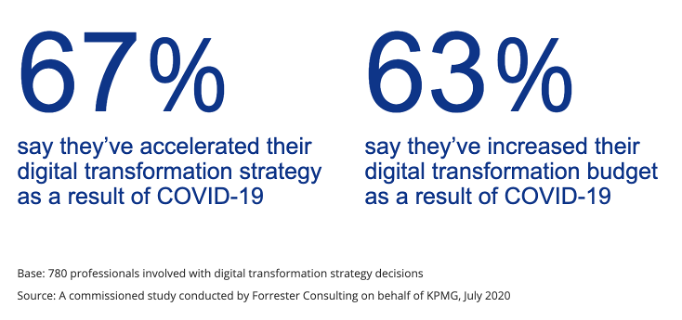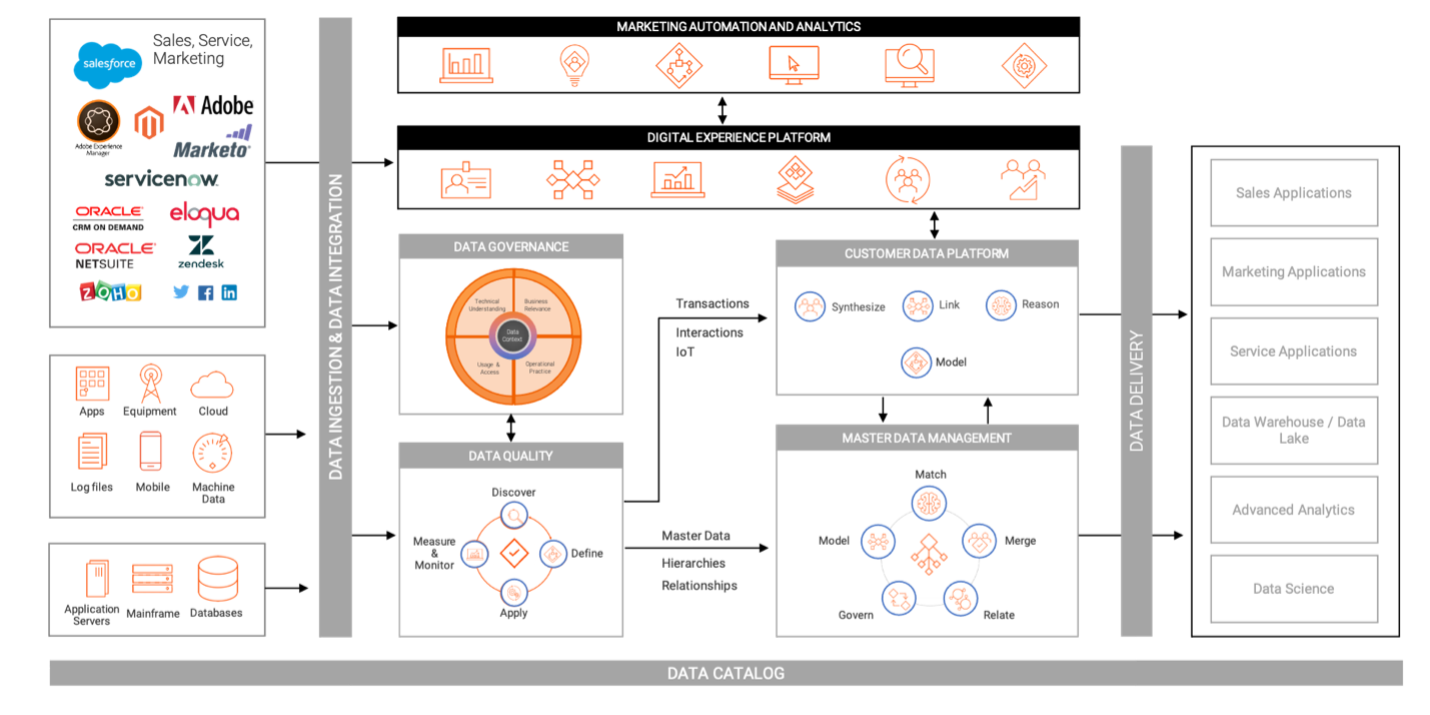How to Create and Execute a Customer-Centricity Strategy

Customer-centricity is putting the customer first in everything you do. Think of customer-centricity as your internal customer compass. Customer experience is the impression that customers have about your company at every step of their journey with your brand. Think of customer experience as your external face to the world. Expectations for seamless, personalized experiences and service are higher than ever before. And, customers are not afraid to walk away if their expectations are not met. Building a customer-centric strategy to power great customer experience is critical to success no matter your industry.
The channels in which customers interact with your organization are quickly evolving. In-person customer relationships have rapidly been replaced with online digital experiences. The COVID-19 pandemic has expedited 10 years of digital adoption to happen in less than 3 months for organizations of all sizes across many industries. According to a recent KPMG survey, organizations are investing heavily in technology to build longer-term competitiveness and resilience.

To deliver exceptional customer experiences, an organization must establish a culture of putting the customer first. Customer-centricity is the belief and practice that the customer is at the heart of everything an organization does. Data and technology then become enablers of a customer-centricity strategy. An integrated set of capabilities is required to architect for customer experience.
What enterprise architects need to know in order to execute a customer-centricity strategy
Typically, the customer relationship is owned by marketing, sales, and account teams. When considering a data-first approach to customer centricity, enterprise architects are a key stakeholder because they are responsible for overseeing, improving and upgrading enterprise services, software and hardware. Applications that manage customer data are critical to providing marketers and other customer-facing users with insights that help deliver on customer-centricity.
To apply data and technology to fulfill a customer-centricity vision and enable seamless customer experiences, enterprise architects must take into account and plan for several considerations.
The first step is to identify where customer data resides and how can it be mapped to the new digital world. Next, evaluate how to combine data from traditional sources such as ERP and sales systems, and master data management (MDM) with digital marketing profiles. It is also critical to ensure personally identifiable information (PII) is secure and protected and in compliance with enterprise data standards as well as government and industry regulations.
Another consideration is how to build a high-quality, connected data set in a reasonable time frame. Many times, organizations will settle on a good enough view of the customer based on traditional methods of stitching data together because it is too costly to pull together a broader view.
Enterprise architects are challenged with simplifying how data is brought together and made available to those who need it to deliver good customer experiences. They must consider the business’s desire to be more and more real-time. This could mean being able to use data to make decisions at the point of interaction – while a customer is in a store, speaking with a call center rep, or checking out online or via a mobile application.
Guiding principles for your customer-centricity strategy
A customer-centricity strategy must be supported by flexible and scalable technology solutions that accommodate real-time data from nontraditional sources and address continually evolving use cases. Customer data presents many challenges in that it is sometimes sparse or fragmented, often duplicated across many systems, and may be heavily regulated, requiring strict adherence to privacy guidelines.
Enterprise architects must address these myriad challenges and determine how best to manage and extract insights from data while ensuring it is actionable by the business to fulfill their customer-centricity vision. Here are key principles to keep in mind when building your customer-centricity strategy:
- Enabling employee productivity. How can I empower teams across the business to use data and insights from traditional channels in the digital world?
- Protecting customer data. How do we safeguard our data and comply with existing and new data privacy regulations?
- Ensuring simple, repeatable processes. How can we deliver trusted data without spending cycle after cycle cleaning data and figuring out how to stich the data together?
- Facilitating real-time visibility and meaningful interactions. How do I architect a platform that enables us to understand and engage with our customers in near real-time?
- Driving growth at scale. How can we keep up with the volume of data and the pace of new requests, and reduce our time to delivery?
Customer-centricity use cases by industry
Organizations across a variety of industries are putting in place capabilities to improve marketing, sales, and customer service/support, resulting in more meaningful relationships. Each of these examples represent a customer-centricity model that puts the customer at the center of their customer experience strategy.
Telco/media
In the highly competitive market of TV and cable service providers, the race to acquire customers has shifted to acquire and serve the right customers that will prove to be the most profitable relationships. Providers, such as KPN, are taking advantage of data to tailor promotional offers for new streaming businesses based on historical set-top box viewing preferences.
By implementing customer-centric data and insight capabilities, telco and media providers can more intelligently:
- Serve up recommendations (e.g., you watched X, you might like Y) to encourage greater adoption
- Group like customers together (e.g., sports fans) to build better segmentation for highly targeted marketing campaigns
- Identify whether someone may be interested in additional services (e.g., family content) for more successful upsell/cross-sell
“By introducing the 360-degree view of our customers and providing clean, trusted data in near real-time, Informatica is helping KPN raise the bar in terms of customer satisfaction, target customers with compelling cross-sell and up-sell opportunities and reduce marketing and sales time to market.” - Thomas Reichel, Senior IT Architect, KPN
Travel and hospitality
Hotels and airlines are readying themselves to win customers back post-pandemic when travel returns. Leaders in this space, such as The Travel Corporation, invest in capabilities to bring data together across digital/online and different sources (e.g., reservations, loyalty programs) to personalize offers and experiences. Here are some specific examples how data-driven insights can help:
- Use commentary received during reservation (e.g., floor or pillow preference) to tailor offers and experiences by capturing that feedback, associating it with the correct customer profile and making it available to customer-facing personnel.
- Match data captured during a stay at one property (e.g., business travel at London location) with data captured during stays at other properties (e.g., leisure stay in Hawaii) and bring it together in a single view of the customer across the enterprise, to recognize loyalty.
- ·Identify the customer/guest across each channel (e.g., online, mobile app, in person) to deliver consistent and seamless experiences.
“Gaining a 360-degree view of the customer is critical to our business model that emphasizes high-touch, highly tailored services. By adding Informatica’s Cloud MDM to Salesforce, we were able to see all interactions with our customers no matter how they choose to communicate with us, regardless of whether it’s by mobile, social, phone or the website." - Jon Pickles, Global Director, 360 Engagement, The Travel Corporation
Business to business (B2B)
As more B2B buyers demand consumer-like experiences, the need to use data to deliver personalized and convenient experiences is critical. B2B companies, such as Citrix, need to create 360-degree views of their accounts and contacts by linking interactions and transactions together across potentially hundreds of systems to better understand hierarchies, personalize interactions and identify next best action. Here are a few examples how B2B companies are using data to drive customer-centricity:
- Increasing account-based marketing (ABM) value: Grow wallet share and accelerate account penetration for targeted outreach by connecting stakeholders and identifying needs through a trusted view of contacts, accounts and behaviors.
- Optimizing segmentation: Deliver higher-quality sales qualified leads (SQLs) and marketing qualified leads (MQLs) for increased lead conversion by creating highly targeted segments and more personalized offers through added firmographics and third-party data insights.
- Improving cross-sell/up-sell: Optimize offer bundling strategies for higher acceptance rates by mapping a complete view of the customer journey through linking the products owned, services used and license renewals.
- Promoting retention and loyalty: Produce five-star service levels and grow customer trust and loyalty, supporting first-call resolution through a better understanding of product usage and customer satisfaction metrics such as NPS.
- Knowing the next best action/offer: Uncover the next best offer, action or advice for well-timed and relevant interactions by identifying who will buy, what they will purchase and when they will buy through predictive models applied to a deep awareness of buying stages.
“Our primary goal is to drive pipeline for sales and we’ve been able to tie a 20% lead conversion improvement with MDM. The holistic view of data and the ability to perform predictive analytics will give us almost fortune teller-like abilities.” - Dagmar Garcia, Senior Manager, Marketing Operations, Citrix
Building a deeper understanding of the customer
No matter the industry, the key to delivering better experiences is to put the customer at the center of every action and decision. This is true from a data architecture standpoint as well. Creating a broad and trusted view of the customer fuels personalized and authentic interactions.
The core customer profile is comprised of master data along with third-party and digital data across channels that is brought together, matched and deduplicated to ensure the customer can be confidently identified. Once data is stitched together, you can perform analytics to identify segments, predict actions and understand sentiment. With these insights, you can take appropriate actions like making product recommendations, building targeted campaign segmentation, optimizing customer journeys, and performing analytics to identify customer lifetime value (CLV), next best action or churn risk.

The goal is to build a broad view of the customer, incorporating all known information from structured and unstructured sources, so you can put the data and insights into action and create hyper personalized customer experiences.
Capabilities required for customer-centricity
Informatica has created a reference architecture to give marketers and data scientists control over their data. With a focus on productivity, privacy, simplicity, performance and scale, our enterprise capabilities are designed with the customer in mind and help architects address the challenges associated with getting value out of customer data.
Enterprise architects can implement these capabilities to capture, manage and store data from a variety of channels — including first-party data, digital, behavioral and campaign data — making it easier to analyze and act on large quantities of data efficiently and accurately.
Let’s quickly walk through the capabilities needed for customer-centricity:
Data integration and delivery
Customer experience brings the complexity of ingesting data from many sources, as data about your customer resides in several systems in different forms and levels of completeness. You need an integration platform to connect different systems across various channels to bring the data together in large-scale batches as well as in real time. You also need a way to deliver data to consuming systems and applications.
Data governance and quality
Often, the biggest risk of adoption for customer-oriented systems is a lack of trust in the data itself. And, it’s usually because data governance is overlooked or underestimated. Data governance capabilities ensure data is complete, high-quality, understood secure and accessible to the right users.
Master data management
To create a single, accurate view of the customer, you need to aggregate core customer and related data, including product and supplier information. Since many data elements may be duplicated across various systems, you need a master data management solution to match, merge, consolidate and enrich data to build a single view of the customer across the enterprise.
Customer data platform
A customer data platform (CDP) enables you to connect interactions and transactions, preferences and third-party data to customer profiles to perform analytics such as segmentation, sentiment, customer journey, behavioral analysis and fraud/anti-money laundering. A customer data platform provides your marketing automation tools with a deep understanding of the customer to improve marketing campaigns and personalization.

Best practices for building out your customer-centric vision
Customer experience is not a set of technologies. For the tools to provide meaningful customer value, you also need a holistic company approach to customer-centricity. Here are best practices to consider:
1. Establish strong commitment at the executive level: Get commitment at the executive level to support the organization’s customer-centricity culture, values and vision. This requires collaboration between both business and IT, not just one area.
2. Focus on the outcome to create the solution: Think about and define the desired business outcomes and then work backward to architect the solution. This step will help you focus on the right data and marketing technologies needed to address the specific use cases identified.
3. Design for a consistent, accurate, real-time view of all relevant information: Lack of adoption of customer experience initiatives is often due to a lack of trust in the data itself. To ensure adoption, provide users with high-quality, complete data.
4. Ensure flexibility in your design, not a locked-in, standalone product: Use flexibility and agility as guiding principles. You’ll need to add new use cases, new types and consumers of data, and new regulations to your customer experience program, so create an architecture that can scale to the demands of the enterprise over time.
Learn more about customer-centricity strategies
In today’s digital world, data is the difference between a good customer experience and a poor one. Building an enterprise data strategy centered around the customer will ensure the information you have about your customers is best positioned to help everyone in the organization deliver exceptional experiences. To learn more, read The Ultimate Guide for Customer Data Management ebook.








